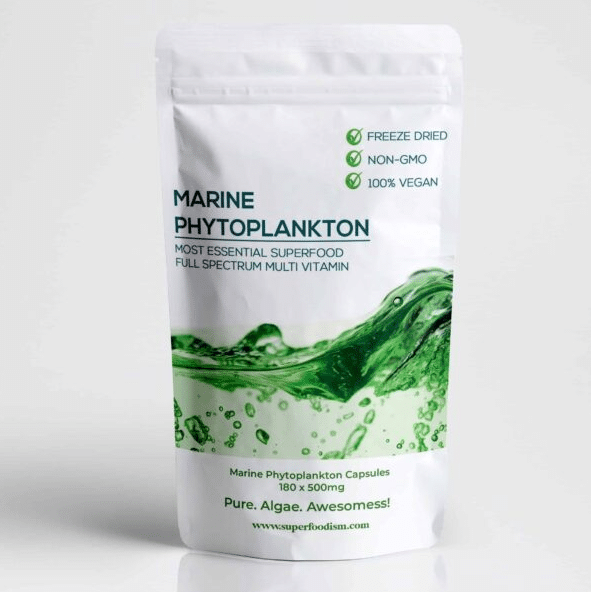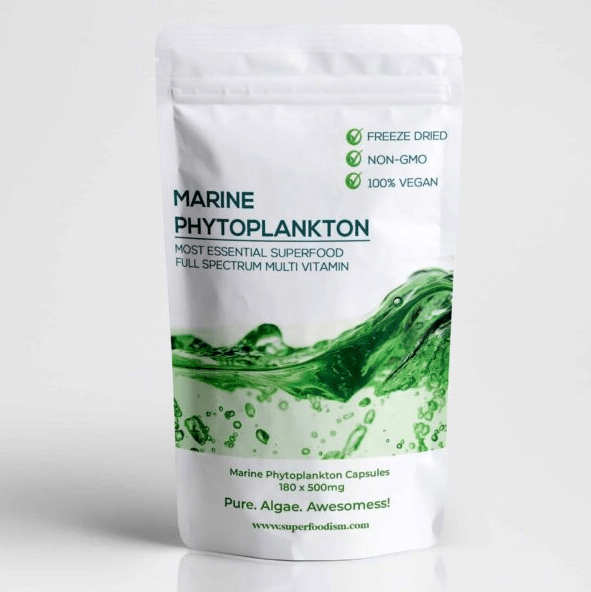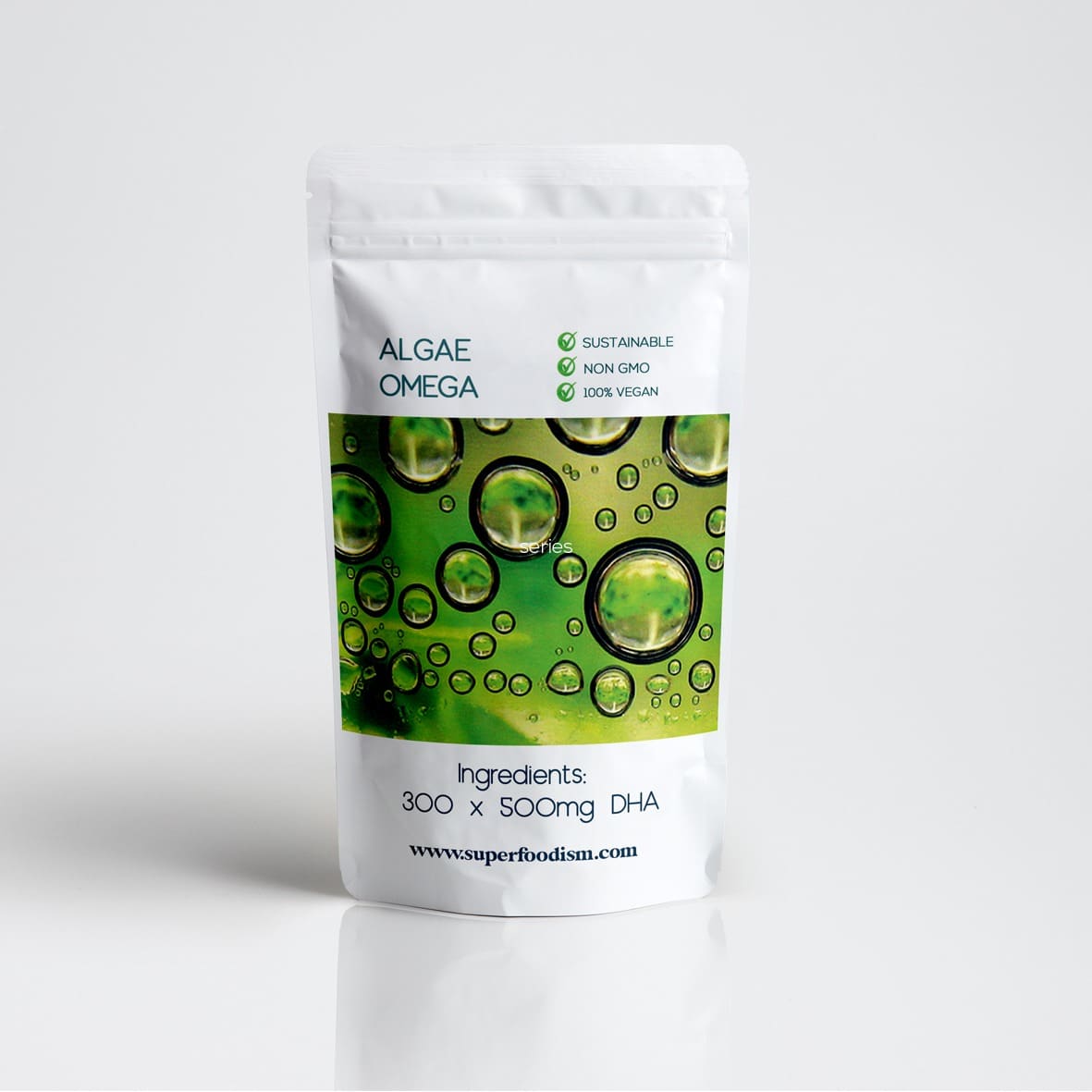Sure thing! Phytoplankton has been around for a while, but it used to be really high-priced because of expensive technology and low production volumes. It just didn’t make sense, both in terms of nutrition and cost. But for a while now, things have changed. We’re thrilled to let you know that you can get marine phytoplankton on this website for a much more reasonable price than elsewhere online. We’re talking about 100% pure Nannochloropsis Gaditana powder or veggie caps. Forget about those diluted and pricey dropper bottles that barely have any actual phytoplankton. What we offer is strictly the real thing, without fillers, binders, or flowing agents!

“The future of nutrition is found in the ocean” said Jacques Yves Cousteau.
Indeed, that future has now unfolded. Harnessing the power of modern bio-reactor technology, marine phytoplankton has evolved significantly from its origins in the ocean. After years of being prohibitively priced, this ‘king of superfoods’ is now accessible to all.
Marine phytoplankton stands out as a superfood that should find its place in everyone’s daily routine, and here’s why: Dr. Mark Hyman, a medical doctor and advocate of Functional Medicine, highlights that around 99 percent of people are deficient in omega-3 fatty acids, a deficiency with far-reaching implications for our biochemistry and overall health.
Enter phytoplankton, a rich source of omega-3 fatty acids (EPA) and a treasure trove of other nutrients. As the foundation of the marine food chain, it boasts an impressive array of proteins, chlorophyll, amino acids, minerals, pigments, enzymes, and trace elements.
Traditionally a crucial food source for marine animals, recent advancements in photobioreactor technology have made phytoplankton accessible to humans directly. This technology eliminates the need to rely strictly on fish or fish oil, offering a contamination-free product with high bioavailability. This development is particularly promising for vegetarians and vegans.
Among the vast array of phytoplankton species, only a select few are fit for human consumption. Extensive research by microbiologists and nutritionists has identified Nannochloropsis Gaditana as a standout species due to its exceptional nutritional profile. Cultivated in technologically advanced photo-bioreactors using natural sunlight and photosynthesis, this phytoplankton species grows uncontested, eventually forming the biomass that is harvested and dried. Welcome to the era where the nutritional powerhouse of the ocean is not just a concept but a reality for everyone.
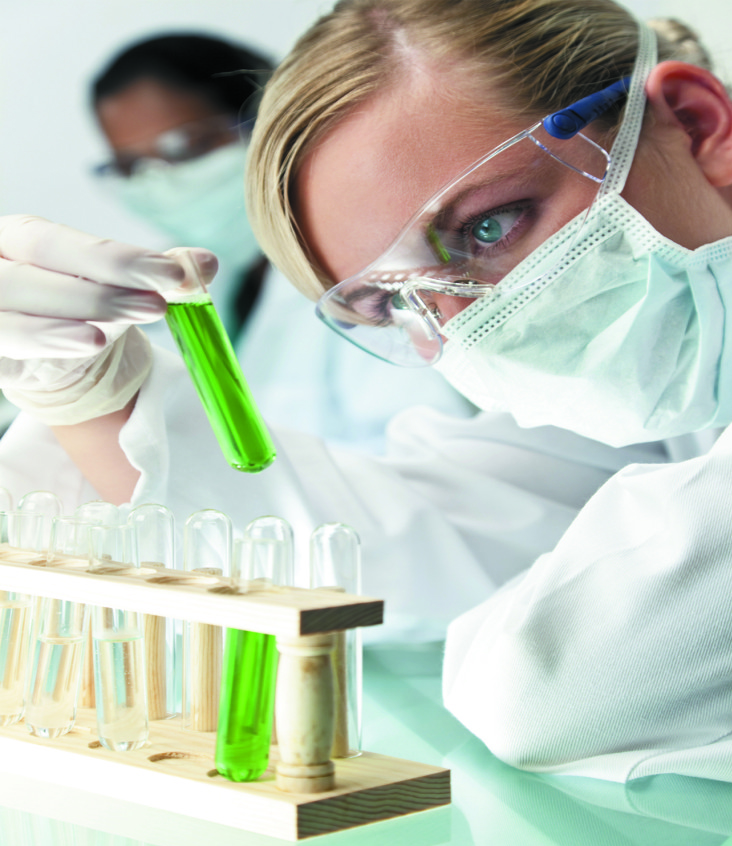
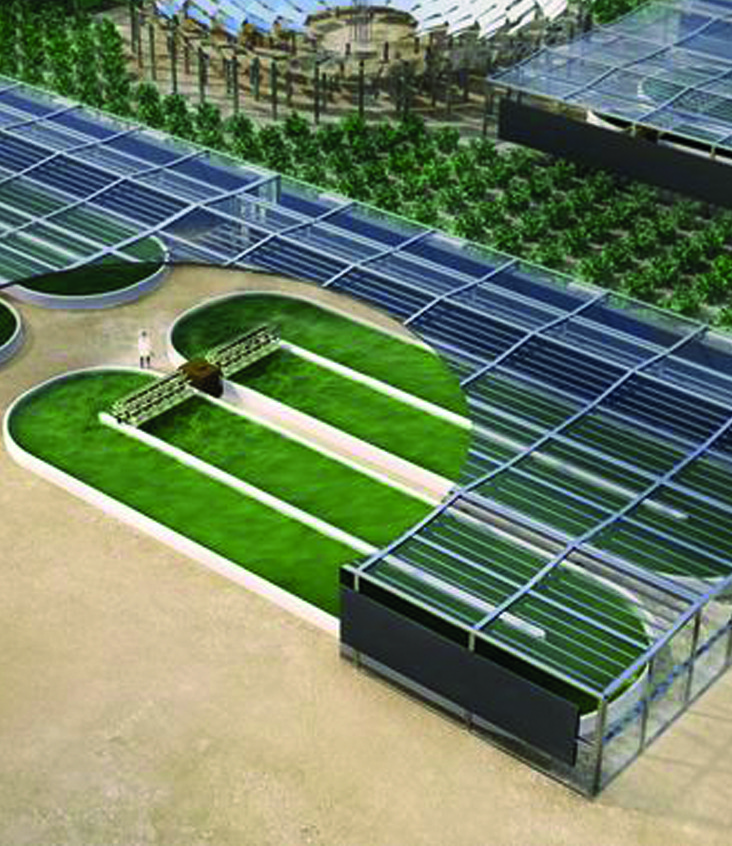
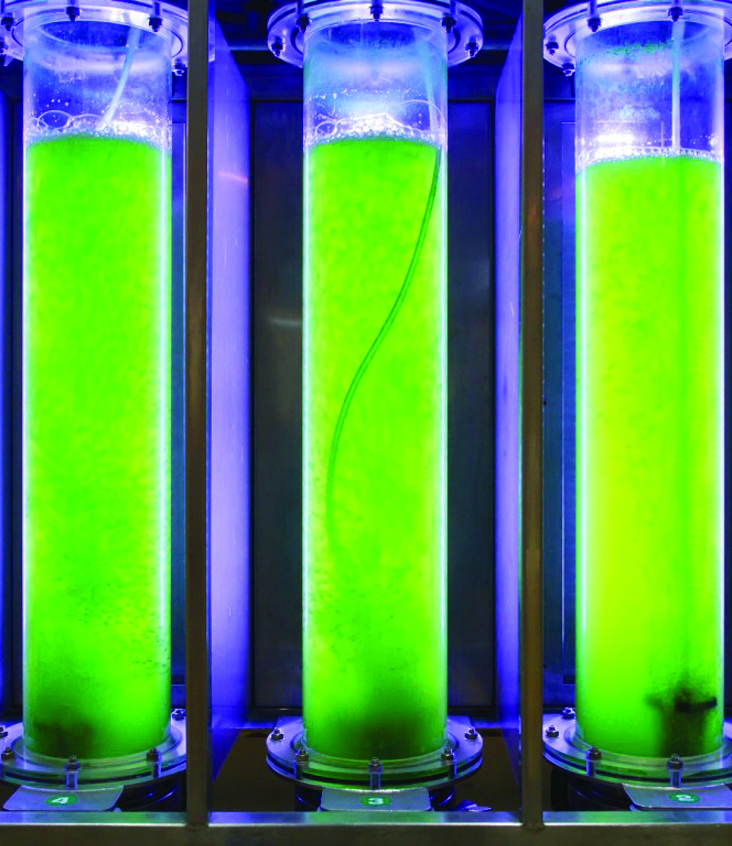
Bio Reactor Technology
Our photo-bioreactor technology ensures a pure and safe product. In simple terms, we continuously supply nutrients, CO2, and oxygen to the reactors, ensuring that the algae have everything they need for optimal growth and development.
Is Marine Phytoplankton Expensive?
Traditionally, most phytoplankton was grown in costly tubular photo-bioreactors, limiting production volumes and driving consumer prices sky-high. Fortunately, those days are now behind us! Our phytoplankton is cultivated in a more traditional ‘open pond’ system, albeit within a controlled greenhouse environment. This greenhouse serves as the photobioreactor, allowing us to meticulously control all growth parameters. The result? High-quality algae at a significantly reduced price.
Now is the time to start prioritizing the well-being of yourself and your loved ones by providing essential nutrients to your body and brain. This revolutionary source comes from a completely clean and sustainable process, marking a new era in nutrition.
Why Choose Phytoplankton?
Phytoplankton is a valuable and comprehensive food source, providing the body with vital nutrients for the production of healthy cells and neurotransmitters. It boasts an alkaline pH, promoting optimal body acidity—a critical factor for good health.
A Quick Look at Marine Phytoplankton’s Nutritional Profile:
- Complete protein (50%)
- Chlorophyll and EPA (healthy omega-3 essential fatty acids)
- Phospholipids (facilitating the absorption of EPA and other omega-3 fatty acids)
- Vitamins, Minerals, and Pigments
- Beta-carotene, Zeaxanthin, Violaxanthin, Antheraxanthin, Vaucheriaxanthin (potent antioxidants)
For maximum benefit, incorporate 3/4 gram or 6/8 capsules of 500 mg daily into your routine.
Featured Products
Omega 3 Fatty Acid EPA
The brain is 60% lipid. It requires a diet rich in omega-3 fatty acids for optimal function.
EPA, short for Eicosapentaenoic acid, is a crucial Omega-3 fatty acid that the human body requires. Since our bodies can’t produce EPA on their own, we need to obtain it from our diet or supplements. Getting an adequate amount of EPA has numerous health benefits.
So, how do we get EPA?
While ALA, another form of omega-3 fatty acids, is found in vegetarian foods like nuts, beans, and leafy greens, it’s present in small amounts and needs to be converted by the body into EPA. The conversion rate for ALA to EPA is around 21% in young, healthy adults, but this varies for many people, often being less efficient. Additionally, having enough ALA-containing foods in the diet is crucial, which is not the case for many people.
Traditionally, fatty fish like mackerel, anchovies, sardines, salmon, and tuna were considered the best sources of EPA. However, these fish get their EPA from consuming algae or smaller fish that eat algae. By directly consuming marine phytoplankton, we skip the middleman and go straight to the source, which makes sense in our modern era. Why? Because there’s a serious issue with fish — they’re heavily polluted with toxins and heavy metals. If overfishing continues, oceans could be empty by 2050. Marine phytoplankton offers a safe and sustainable alternative.
A superior way to get our Omega 3
Farmed fish, ironically, lack substantial amounts of omega-3 fatty acids due to their unnatural diet. Marine phytoplankton, on the other hand, provides all the benefits of fish or fish oil omega-3 without concerns about impurities, contaminants, or diminishing fish stocks. It’s an ideal source for vegetarians, vegans, and everyone else who may be omega-3 deficient.
Marine phytoplankton, the foundation of the food chain, has become a cornerstone in modern human diets due to advancements in agriculture and technology. This is crucial because omega-3 fats play a role in various aspects of our biochemistry, controlling gene function, regulating the immune system, influencing metabolism, and forming a vital part of cell membranes. When you lack omega-3 fats, communication between cells falters, impacting the overall function of your body, including your brain.
For a deeper understanding of the significance of omega-3 fats and their impact on the brain, body, and behavior, check out our blog section.
Chlorofyll
9 out 10 people don’t eat enough vegetables! We say: add more green to your life… It’s easy!
Everybody knows that it is important to eat plenty of vegetables. On the other hand it turns out that less than 10% of Europeans are eating the recommended daily amount of fruits & vegetables. One of the reasons we need to eat enough vegetables is to make sure we get enough chlorofyll. Chlorophyll is the green pigment found in all plants. It is the powerhouse of the plant, responsible for energy production. In our body, chlorofyll works as a powerful anti-oxidant.
Naturally, you can find chlorophyll in all green leafy vegetables. However, chlorophyll is easily destroyed during cooking. So, to derive maximum benefits it is better to eat it raw. This can be in the form of vegetable juice,salads or green algae superfoods!
Micro-algae Spirulina, Chlorella and Marine Phytoplankton contain more chlorophyll than any other food source. These superfoods are thus making it very easy to get your daily dose of “vegetables”
The advantages of chlorophyll
Chlorophyll or chlorophyll is a good source of antioxidants . Anti -oxidant food substances such as vitamins A , C and E help to neutralize harmul molecules (free radicals) thatmay cause to damage to healthy cells
Another important benefit of chlorophyll is its role in the production of red blood cells. By making more red blood cells, chlorophyll helps with the growth and maintenance of tissues and helps to heal wounds effectively. Chlorophyll also decontaminates and inhibits the growth of bacteriain the body .
Chlorophyll and chlorophyllin are able to bind with chemicals that are known carcinogens, including polycyclic aromatic hydrocarbons which are found in tobacco smoke. Chlorophyll is known to neutralize polluted air when inhaled, making it an absolute plus for smokers or people who live in the city .
Another charming side effect is that chlorophyll works wonders against bad breath! Chlorophyll works in two ways against bad breath . In the first instance as a deodorizer , it neutralizes odors in the mouth and throat . Second ( and more importantly ) it promotes a healthy digestive system – which is the main reason is bad breath .
But there is more. According to the U.S. NIH (National Institute of Health) chlorophyll also has anti-carcinogenic properties . Chlorophyllin ( CHL ), a water-soluble derivative of chlorophyll , ‘ exhibits strong anti – mutagenic activity against a variety of carcinogens . ” In a study from 2007 140 trout were induced with liver and stomach cancer. They were fed with HL (2000 ppm), which protected them from liver and stomach cancer.
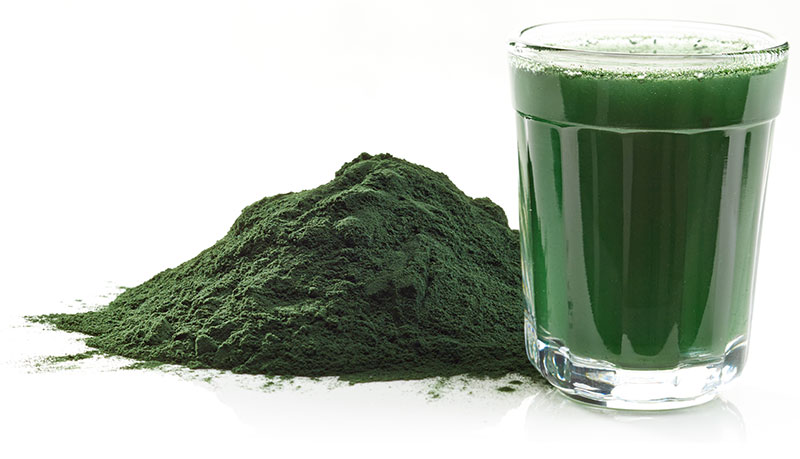
Maintaining healthy , clean blood is essential in the effort to illness and to prevent the diffusion of free radicals The molecular structure of chlorophyll is almost identical to the molecular structure of hemin. Hemin is a part of hemoglobin , a protein that carries oxygen in the blood in the body.
Note the following two structures :chlorofyl-hemoglobine-chlorella
The only difference between the chlorophyll and the hemin is the fact that magnesium (Mg) thecenter of chlorophyll and iron (Fe) central hemin.
Scientists have studied the assimilation of chlorophyll in the body and found that at a certain point the magnesium changes in iron. It is still not known how this process works or how this change is made. .
Nevertheless, the intake of chlorophyll could be regarded as a “green” blood transfusion. The best way to get chlorophyll in the diet is through a chlorophyll supplement like marine phytoplankton or spirulina and chlorella. They can be easily taken in powdered form in smoothies or as tablets.
Another major advantage of chlorophyll are it’s properties as chelating agent. Chlorophyll binds with toxic heavy metals in the body and it will be removed safely.For example, mercury is a toxic metal that chlorophyll can remove well. Chlorophyll is a great option for those with mercury fillings in their teeth or those who they just have it removed . Often is much mercury is released in the body in this procedure.
http://onlinelibrary.wiley.com/doi/10.1111/j.1365-2621.2002.tb08782.x/abstract
http://www.ncbi.nlm.nih.gov/pubmed/18069110
http://www.scirp.org/journal/PaperInformation.aspx?paperID=35234#.U2ZFqfl_vJI
http://www.sciencedirect.com/science/article/pii/S0963996910004898
Bio Availability
You are what you eat? Or what you absorb?
Bioavailability is the ease with which any nutrient can make its way from the food you eat into your body. The bioavailability “journey” that every nutrient takes is the same. In the first part of the journey, the food must be digested (broken apart) so that the nutrient can be freed from the food that contained it. Once the nutrient has been freed from the food that contained it, the second part of the journey involves absorption of the nutrient from the digestive tract into rest of the body.
When a nutrient is highly “bioavailable,” it can be digested and absorbed a high percentage of the time and in a dependable way. When a nutrient is poorly bioavailable, its digestion, its absorption, or both can be much more difficult and much less predictable.Typically, we don’t have to worry about the bioavailability of nutrients from our food if we eat in a healthy way and have healthy body function.
The reality is that the majority of us don´t have optimal diets and even when eating healthy, due to modern agricultural practices it has become increasingly difficult to get enough micro-nutrients from our food. That’s where supplementation can come to the rescue.
One of the most important things to keep in mind when choosing supplements is to always opt for whole food supplements instead of isolated or synthetic nutrients. Phytoplankton is such a whole food supplement.
Why are whole foods better? No one knows for sure, but it’s probably because the components of food are only one part of the complex balance of nutrients, chemicals and the interactions between them in the human body. Overwhelming part of that system with large doses of one component likely leads to actions and adjustments that are unintended and/or counterproductive within these systems.
Micro Algae are better absorbed than fish oil
Marine phytoplankton is not only a sustanainable alternative for fish oil, it is also superior to fish oil. Why? The key nutrient EPA only achieves an optimum level of bioavailability for the human body when they are present in the phospholipid portion of fats. Phospholipids are needed to transport the important nutrients into your system, and then directly into your brain.
The EPA in phytoplankton is better absorbed than from fish oils because they can more easily cross what is called the blood/brain barrier to your brain. This barrier protects the brain from most foreign substances that come near it, not allowing them inside. In other words, the transfer mechanism to your brain (where you need these essential fats the most), is more efficient with micro-algae.
When we consume phytoplankton, we use the phospholipids in order to help transport the EPA to the cells of our body. It is not surprising therefore that the EPA that is stored in human cells is mainly in the phospholipid form, and only a small amount is in the triglyceride form.
Fish oils contain mostly triglycerides and only a small amount of phospholipids, that is why consuming phytoplankton is a better and more efficient way of getting omega-3 into the body than fish oil.
The BS on PHYTO
Don’t believe the Hype!
When shopping for marine phytoplankton there are a few things to be aware of:
- Don’t buy dropper bottles from any brand. You may be only getting 1500mg (1,5 gram) of phytplankton. For your reference:at $40 dollars a piece that’s $26,6 per gram = $26,6000 per kg! Now this may be an excellent business model, but is of zero value for you, the consumer.
- Buy only 100% pure nannochloropsis powder, capsules or tablets. Accept no fillers, binders, preservatives or any kind of additives to your algae supplement!
- A certificate of analysis (COA) should always be presented, at least upon request. This will not only give you a complete nutritional breakdown of the product, but will also assure you that heavy metal content is within safety limits and that there are no toxins present.
- Make sure that the producer is abolutely clear on the drying method. No excessive heat should be used when drying marine phytoplankton. This will lead to a significant loss in vital nutrients. So freeze drying or thermal drying using low temperature are preferred over spray drying!
- How much bang am I getting for my buck? General consumer prices up to now were and in many places still are around €1 euro per gram. We are now able to offer you our high quality phytopklankton for € 0,33 cents per gram. The minimum recommended daily intake is 4 grams. Four grams translates into 240mg of EPA daily. The daily recommended dose is 220mg. So for €1.30,- you’re getting you daily fix. That’s half the price of a cup of coffee at your local coffeehouse.
We love algae and we certainly dig marine phytoplankton!
You won’t find any outlandish nonsense here about this humble algae.
But we will share some random BS about phytoplankton that we stumbled upon:
- “Marine Phytoplankton contains every known vitamin and mineral…” –That ofcourse is a pretty bold statement. And simply inaccurate. Although phytoplankton is highly nutritious, it contains 8 of the 13 essential vitamins and 8 out 0f 16 essential minerals.
“1500mg of marine phytoplankton, in a 2ounce/60ml bottle – highly concentrated and highly potent!” – Although 1500 may sound like alot we are really only talking 1,5 gram of marine phytoplankton. This is far from concentrated and highly potent considering 2ml is the recommended daily dose. Not even the whole dropper will get you enough for the day.
- “It is especially rich in the vital Omega-3 fatty acids Docosahexaenoic acid (DHA) and Eicosapentaenoic acid (EPA)”.This is inaccurate. Although phytoplankton does contain EPA and EPA is converted in our body into DHA, it doesn’t actually contain significant levels of DHA
Join our newsletter!
We'll keep you in the loop on our exciting offers and regularly share fascinating insights about the amazing world of algae and the benefits of a whole food plant-rich diet!
Address
SuperFoodISM
Moezelhavenweg 91 - 1043AM Amsterdam The Netherlands
Call us
(+31)-20-3413410
(+31) 6-46024298
info@superfoodism.com



